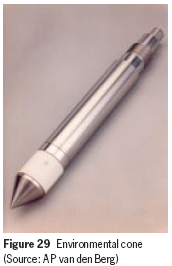Chapter 4
Part 2: Special cones: geo-environmental cones
Environmental cone
| ENVIRONMENTAL CONE 4.10 Contaminated sites The environmental cone (Figure 29) is designed for the investigation of contaminated sites. There are countless examples of areas with soil polluted with chemicals and oil to such an extent that it represents a direct danger to health. Measurements Normally these probes are combined with a piezocone, measuring porewater pressure, sleeve friction and tip resistance. The environmental measurements of the groundwater are the acidity (pH), the oxygen exchange capacity (redox potential) and temperature with depth while being pushed into the soil. Measurement of the electric conductivity can also be incorporated. The parameters are major variables of chemical equilibrium for inorganic substances such as oil and chemicals. |  |
| Method The sensors are mounted inside the cone. A groundwater sample is drawn into a measuring cell, located a short distance behind the cone tip. Measurements are made under a nitrogen atmosphere to reduce the exchange of atmospheric oxygen with dissolved gases from the groundwater. A slight excess pressure of nitrogen is used during penetration of the probe to stop the flow of liquid into the measuring cell. The nitrogen is supplied from a small nitrogen cylinder in the probe. The stainless steel porous filter is cleaned by the excess nitrogen. A pressure sensor is also included to monitor the flow of liquid into the measuring cell and to estimate the hydraulic conductivity of the surrounding soil. The measurements enable the detection of the magnitude and type of pollution. In this way the method offers an objective choice of whether or not further laboratory analysis is needed and is therefore secure, timesaving and cost efficient. | |
